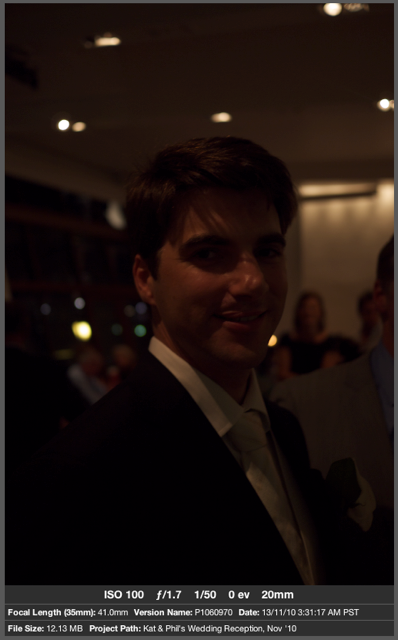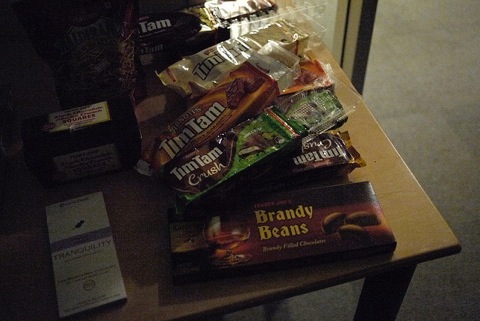Learning Photography with the Panasonic GF1
Thanks to several evil friends of mine, I started to take an interest in photography at the end of last year. I’ve always wanted to have a “real” camera instead of a point and shoot, so at the start of 2010, I bit the bullet and bought myself a Panasonic Lumix DMC-GF1, usually just called The GF1 amongst the camera geeks.

I tossed up between the GF1 and the then-just-released Canon EOS 550D (a.k.a. the Rebel T2i in the USA) for a long time. I figured that getting a compact camera would make me tote it around a lot more, and after ten months of using it, I think I was right. I recently went to a wedding in Sydney, and I literally kept the camera in my suit pocket instead of having to lug it around strapped to my body or neck. I definitely wouldn’t be able to do that with a Canon or Nikon DSLR. The camera’s so small with the kit 20mm f/1.7 lens that I stopped using the UV filter with it, because I didn’t like the 2-3mm that the filter added to the camera depth. Here’s a size comparison of the Nikon D3000 vs the GF1.

(Image stolen from dpreview.com’s review.)
I won’t write up a comprehensive review of the GF1 here; other sites have done that, in much more depth than I can be bothered to go into. If you’re after a good review, the three articles that swayed me to the GF1 in the end were DPreview’s review, and Craig Mod’s GF1 photo field test article and video tests. What follows is my own impressions and experiences of using the camera. The one-sentence summary: the GF1 perfect for a DSLR newbie like me, the micro four-thirds lens system it uses looks like it has enough legs that your lens investments will be good for the future, and learning photography with the GF1 is great and deserves a Unicode snowman: ☃.
The reason you want the camera is to use the 20mm f/1.7 lens. For the non-photography geeks, that means that it’s not a zoom lens, i.e. you can’t zoom in and out with it, and the f/1.7 means that it can take pretty good shots in low light without a flash. All the reviews of it are right: that lens is what makes the camera so fantastic. Do not even bother with 14-45mm kit lens. The 20mm lens is fast enough that you can shoot with it at night, and the focal length’s versatile enough to take both close-up/portrait shots (whee food porn), and swing out a bit wider for landscape photos or group photos. It’s no wide-angle nor zoom and it’s not a super-fast f/1.4, but it’s versatile enough and so tiny that you will end up using it almost all the time. It feels weird to get a DSLR and only have one lens for it, but the pancake 20mm lens is so damn good that it’s all you really need. The only thing it really can’t do at all is go super-zoomalicious, for wildlife/distance shots.

The 20mm non-zoom (a.k.a. “prime”) lens has another advantage: it teaches you to compose. Despite all the technology and all the geek speak, photography is ultimately about your composition skills. Prime lenses force you to move around to find the perfect framing for the shot you’re trying to do; I think learning with a prime lens moves your composition skills along much faster than it would if you were using a standard zoom lens. If you’re a photography beginner, like me, shoot with a prime. It’s a totally different experience than shooting with a zoom, and you learn a lot more. Plus, primes are cheap: the Canon 50mm f/1.8 is USD$100, and Canon’s near top-of-the-line 50mm f/1.4 is USD$350. The Canon 35mm f/2, for something that’s similar in focal length to the Panasonic 20mm prime, is USD$300. (You need to multiply the 20mm by 2 to convert between micro four-thirds and 35mm framing, so the actual focal length of the 20mm in traditional camera speak is 20mm*2=40mm.)
After playing it for a few months, you realise that the GF1 is a fun camera to use. The combination of the 20mm prime lens, the super-fast focus, the size, and the great UI design just begs you to take pictures with it. You feel like you’re wielding a real camera rather than a toy: one that wants you to shoot with it. It’s not imposing like a bigger DSLR so it doesn’t feel like the camera is with you all the time, but it’s not so small that you feel like you’re just snipping super-casually with something that’s cheap. And did I mention the excellent UI? It’s excellent. The better controls are a good reason to get the GF1 over its rivals, the Olympus EP series.
One big bonus: I’ve found that the full-auto mode (“iAuto” as Panasonic brands it) very rarely gets stuff wrong. This is useful if you hand the camera over to someone else who doesn’t know how to use DSLRs so that they can take a picture of you… or, like me, if you just don’t know quite what aperture/shutter speeds to use for the particular shot you’re taking. The full-auto just adds to the joy of using it. I usually shoot in full-auto or aperture priority mode, but honestly, I could probably shoot on full-auto mode all the time. I can’t recall a single occasion where it didn’t guess f/1.7 or a landscape correctly.
Do follow DPreview and Craig Mod’s advice and shoot RAW, not JPEG. Honestly, I’d prefer to shoot JPEG if I could, but RAW lets you turn some bad shots into good shots. I use it because gives you a second chance, not because I want to maximise picture quality. Here’s one photo that was accidentally taken with the wrong settings: I had the camera on full-manual mode, and didn’t realise that the shutter speed and ISO settings were totally incorrect.

However, since I shot it in RAW, I could lift up the exposure up two stops, pulled up the shadows and pulled down the highlights, and here’s the result:

Seriously, that’s just frickin’ amazing. Sure, that photo might not be super-awesome: it’s a little grainy, and it looks a bit post-processed if you squint right, but it’s still a photo of a precious memory that I wouldn’t have otherwise had, and you know what? That photo’s just fine. If I shot JPEG, I would’ve had no choice but to throw it away. RAW’s a small pain in the arse since the file sizes are far bigger and you need to wait a long time for your computer to do the RAW processing if you’ve taken hundreds of photos, but boy, it’s worth it.
I did finally buy a wide-angle lens for the GF1—the Olympus 9-18mm f/4-5.6—and have been using it a lot for landscape shots. I bought the Olympus 9-18mm over the Panasonic 7-14 f/4.0 because it was cheaper, and also smaller. I figured that if I was getting a GF1, it was because I wanted something compact, so I wanted to keep the lenses as small as possible. (Otherwise, if you don’t care about size, then a full-blown Canon or Nikon DSLR would probably serve you much better.) I’ve always wanted a wide-angle lens from the first day that I asked “how do those real estate agents make those rooms look so bloody large?”, so now I have one, woohoo. The next lens on my shopping will probably be the Panasonic 45-200mm. (Never mind the quality, feel the price!) Here’s a shot taken with the Olympus 9-18mm; click through to see the original picture on Flickr.

The main thing that I wish for in a future version of the camera would be image stabilisation. Panasonic follow the Canon path and put image stabilisation in the lens, rather than in the body. I think Olympus made the right decision by putting image stabilisation in the body for their compact DSLRs; you can keep the lenses smaller that way, and you then get image stabilisation with all your lenses instead of the ones that only support it explicitly, e.g. the 20mm f/1.7 prime doesn’t have image stabilision, boo. In-body image stabilisation just seems more in-line with the size reduction goal for micro four-thirds cameras. I’d love to get my hands on an Olympus EP for a week and shoot with the 20mm to see if image stabilisation makes a difference when it’s dark and the environment is starting to challenge the f/1.7 speeds.
The only other thing I wish for would be a better sensor. The GF1’s great up to ISO 800: at ISO 1600+, it starts getting grainy. 1600 is acceptable, and you can do wondrous things with the modern noise reduction algorithms that are in Lightroom if you really need to save a shot. Shoot at ISO 3200+ though, and it’s just too grainy. This is the main advantage that more traditional DSLRs have: their larger sensors are simply better than the GF1’s. I’ve seen shots taken with a Nikon D50 at ISO 6400 in the dark because a slower f/4 lens was being used, and bam, the shot comes out fine. Don’t even try to compare this thing to a Canon 5D Mk II. The GF1 just can’t do high ISO. Here’s an ISO 3200 shot, which is just starting to get a little too grainy. It’s fine for Facebook-sized images, but if you click through to the original, you’ll see it’s noisy.

But y’know, despite the two nitpicks above, the GF1 is a fine camera, and the 20mm f/1.7 lens is an amazing do-it-all lens that’s absolutely perfect to learn with. There’s really nothing else out there like it except for the Olympus EP range (the EP-1, EP-2 and EPL-1), which you should definitely consider, but get it with the 20mm f/1.7 lens if you do. I’ve had a total blast learning photography with the GF1, and I’ve captured hundreds of memories in the past year that made the investment completely worthwhile. I don’t think I’m at the point yet where I feel like I need another camera yet, but it feels good knowing that the micro four-thirds format will be around for a while so that I can use my existing lenses with future cameras I buy. If you’re interested in learning photography, the GF1 is a fantastic starting point.
Update: Thom Hogan did a comparison between the most popular mirrorless cameras: the Olympus E-PL1, the Panasonic GF1, Samsung NX100, and Sony NEX-5. It’s written for people who know photography rather than for novices, but basically, the GF1 came out on top, with the E-PL1 being recommended if you can live with the worse screen and the far worse UI. That’s pretty much exactly my opinion, too.
